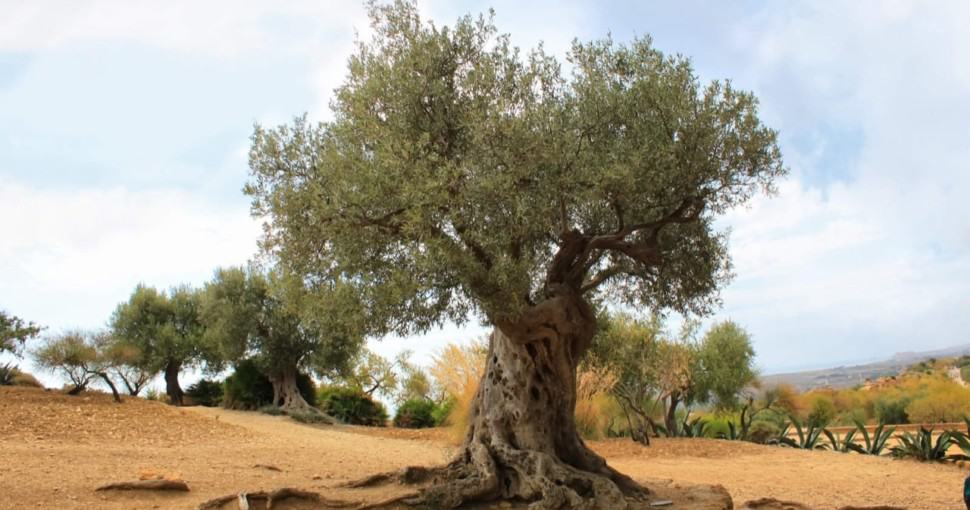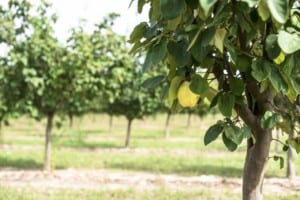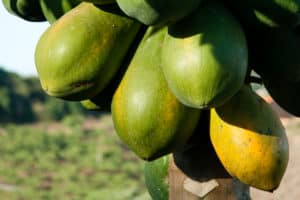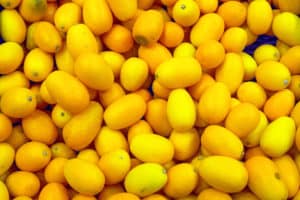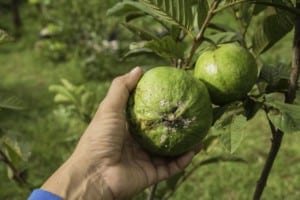If you’re looking for gorgeous trees that can grow fruit or be harvested for oil, then are several varieties of olive trees. Various types of olive trees around some parts of the world have been cultivated for thousands of years. Read on to learn more about them!
Contents
- 1. Arbequina
- 2. Mission
- 3. Picholine
- 4. Manzanilla
- 5. Amfissa
- 6. Nocellara Del Belice
- 7. Gordal Sevillano
- 8. Kalamata
- 9. Niçoise
- 10. Frantoio
- 11. Arbosana
- 12. Koroneiki
- 13. Maurino
- 14. Leccio del Corno
- 15. Piantone di Mogliano
- 16. Cerignola
- 17. Little Ollie® Dwarf Olive
- 18. Nyon
- 19. Alfonso
- 20. Beldi
- 21. Aglandau
- 22. Ascolano
- 23. Chemlali
- 24. Columella
- 25. Coratina
- 26. Hojiblanca
- 27. Itrana
- 28. Leccino
- 29. Lucques
- 28. Pendolino
- 29. Picual
- 30. Taggiasca
- 31. Barnea
- 32. Biancolilla
- 33. Bosana
- 34. Bouteillan
- 35. Bidni
- 36. Canino
- 37. Carolea
- 38. Casaliva
- 39. Celyon
- 40. Cellina di Nardo
- 41. Cobrançosa
- 42. Conservolea
- 43. Cornicabra
- 44. Domat
- 45. Dritta
- 46. Empeltre
- 47. Galega
- 48. Gemlik
- 49. Gentile di Chieti (Nostrana)
- 50. Germaine
- 51. Grossane
- 52. Halkidiki
- 53. Lechín de Sevilla/Ecijana/Zorzaleña
- 54. Mastoidis
- 55. Megaritiki
- 56. Memecik
- 57. Memeli
- 58. Meslalla
- 59. Morrut
- 60. Nabali
- 61. Nafplion
- 62. Nevadillo Blanco
- 63. Olivière
- 64. Patrinia
- 65. Sabine Olive
- 66. Salonenque
- 67. Sevillenca
- 68. Sikitita
- 69. Souri
- 70. Thassos
- 71. Throumbolia
- 71. Tsounati
- 72. Verdial
The olive tree, also known as Olea europaea, is part of the Oleaceae family and is a relatively small tree. It has originated from various Mediterranean countries, specifically Asia Minor and Syria. However, they have also been cultivated in New Zealand, Australia, South Africa, and South America.
The tree or shrub is evergreen with oblong, silvery-green leaves adorning large, twisted, and gnarled trunks. The olive tree is squat and short, with a maximum height between 26 and 49 feet (or 8 and 15 m). However, some variations can grow taller or shorter.
Olive trees also have flowers that are small, feathery, and white. The flowers have ten-cleft calyx and corolla, bifid stigma, and two stamens. In addition to that, some olive tree varieties bear fruit. The fruit does not resemble a typical fruit. Instead, it is a small drupe that can range between 0.39 and 0.98 inches (or 1 and 2.5 cm) in length when it’s ripe. Moreover, the fruit is typically fuller-fleshed and larger in orchard cultivars than in wild plants.
The fruit, known as olives, are harvested in the stage where the color shifts from green to purple. You may see some black olives—those are artificially blackened.
If you plan to grow the plant for its fruit or oil, here are 72 different olive tree varieties to choose from.
1. Arbequina
- Olea europaea ‘arbequina’
- Bloom time: Spring to Early Summer
- Height: 15 to 30 ft.
The Arbequina olive tree produces fruits that are light brown and small. The texture is firm, and it has a mild and fruity taste. Also, the fruit produces fruity oil. Grow the plant in a container to keep it small.
2. Mission
- Olea europaea ‘mission’
- Bloom time: Fall
- Height: 25 to 30 ft.
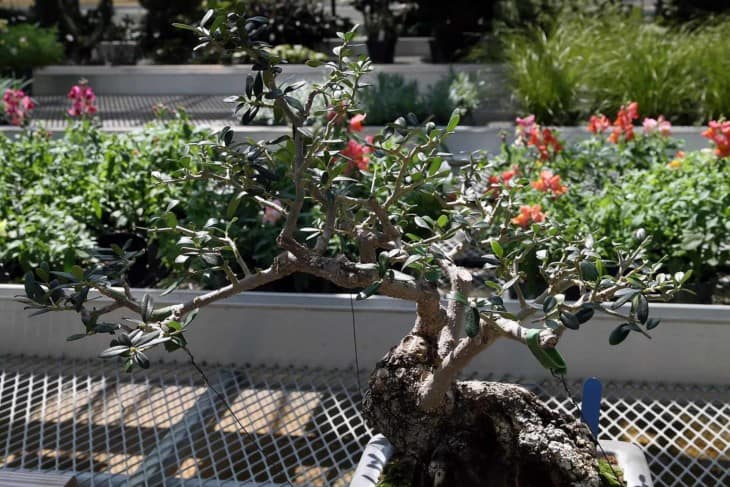
The Mission olive tree is a cold-tolerant tree used for making oil. However, they are also used as a mild-flavored olive for snacking by oil-curing black olives or brine-curing green ones. The USDA growing zones are between 7 and 10.
3. Picholine
- Olea europaea ‘picholine’
- Bloom time: Late Spring to Early Summer
- Height: 20 to 30 ft.
The olives on the Picholine olive tree have a nutty and spicy flavor. While the fruit is an excellent choice for snacking, you can also use it in cooking or produce a mild-flavored oil. It’s best to grow this variety in containers.
4. Manzanilla
- Olea europaea ‘manzanilla’
- Height: 20 to 30 ft.
The Manzanilla olive tree has a gnarled trunk and billowing crown. The Manzanilla olives are the most commonly consumed olives in the US because they taste great and are often cured in brine. The plant can be susceptible to diseases and cold-weather damage.
5. Amfissa
- Olea europaea ‘amfissa’
- Bloom time: Late Spring to Summer
- Height: 20 to 30 ft.
The Amfissa olive tree is a fast-growing tree. Therefore, it typically bears fruit in 3 to 4 years. Moreover, these plants have a growth-spreading habit. You can cure the fruits in brine or citric acid, yielding different flavors.
6. Nocellara Del Belice
- Olea europaea ‘nocellara del belice’
- Bloom time: Late Spring to Summer
- Height: 15 to 20 ft.
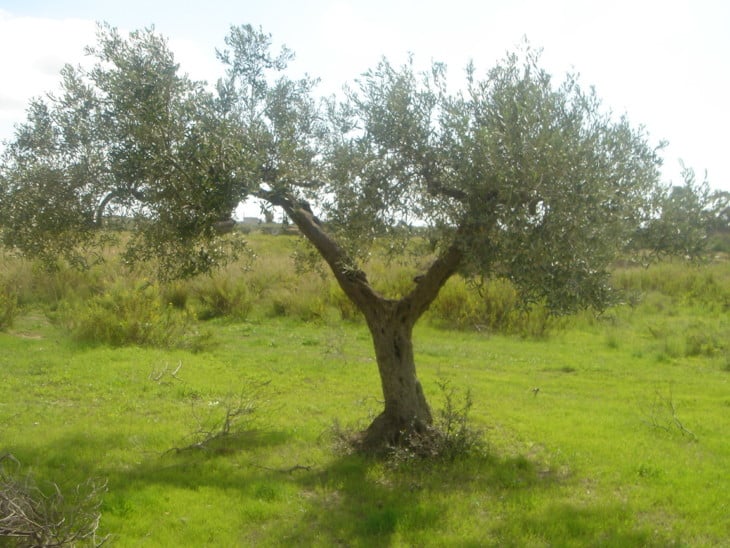
The native area for this plant is Sicily. It is also resistant to disease and pests. Moreover, the dense crown makes it a good but small shade tree. The fruits have a buttery texture and mild flavor.
7. Gordal Sevillano
- Olea europaea ‘gordal sevillano’
- Bloom time: Summer
- Height: 20 to 30 ft.
The plant has medium flowering with white, inconspicuous flowers and has evergreen foliage. It produces fruits that are larger than many other varieties of olives. While it produces large fruit, the oil yield is quite low compared to other varieties.
8. Kalamata
- Olea europaea ‘kalamata’
- Bloom time: Spring to Early Summer
- Height: 20 to 25 ft.
The Kalamata olive tree variety typically has an upright spreading habit. Moreover, the leaves are relatively larger than varieties of olive trees. They also don’t survive well in hot climates. The dark-purple olives have a fruity and smoky flavor.
9. Niçoise
- Olea europaea ‘niçoise’
- Bloom time: Spring to Early Summer
- Height: 20 to 25 ft.
These trees have wide green leaves and weeping (downward-drooping) branches. They are also cold-resistant and self-fruitful. Moreover, the fruits have a herbal, smoky flavor. This is one of the best olive tree varieties for oil production because it yields a lot.
10. Frantoio
- Olea europaea ‘frantoio’
- Height: 20 to 25 ft.
The Frantoi olive tree has beautiful silvery foliage and is fast-growing, so edible olives grow in about 1 or 2 years. The olives are dark in color and have an oval shape. Moreover, these drupes are great for producing oil and eating.
11. Arbosana
- Olea europaea ‘arbosana’
- Bloom time: Late Spring to Early Summer
- Height: 10 to 15 ft.
The Arbosana olive tree is fast-growing, bearing fruit 1 to 2 years after planting. The plant is also relatively small and can be shorter than the figure above after pruning. Also, the oil yield for this plant is high (19 to 20%).
12. Koroneiki
- Olea europaea ‘koroneiki’
- Height: 25 to 30 ft.
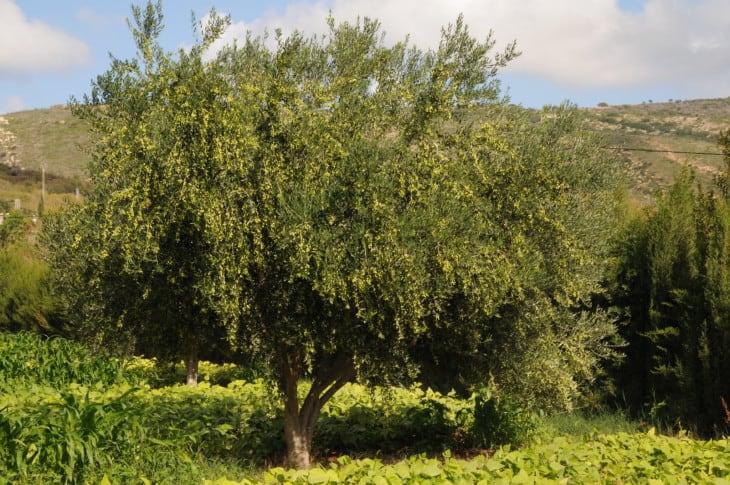
The Koroneiki olive tree is a self-fruitful tree that produces high oil yields. The oil is also stable and high in oleic acid. In addition to that, the plant begins to bear fruit about 2 to 4 years after planting.
13. Maurino
The Maurino olive tree originates from Italy and has lovely gray-green foliage and white, inconspicuous flowers. The fruit on this tree is relatively small, but it is fleshy. So, the oil yield is good with a sweet and aromatic flavor.
14. Leccio del Corno
- Olea europaea ‘leccio del corno’
- Height: 25 to 30 ft.
The Leccio Del Corno olive tree produces high yields of oil (19%). In addition to that, the oil production can double in about 2 years. The plant itself has grey-green leaves and a lush and expanded crown for shade.
15. Piantone di Mogliano
- Olea piantone di mogliano
The Piantone di Mogliano olive tree has high-density fruit and foliage. The fruit is a little rounder than other olives, and they can be medium to large in size and violet or green in color. The oil produced from the fruit has a fruity flavor.
16. Cerignola
- Olea europaea ‘cerignola’
- Bloom time: Spring
- Height: 35 to 40 ft.
The Cerignola olive tree is one of the largest olive tree varieties. It has evergreen foliage, a wide dropping canopy that provides good shade, and has white flowers. Moreover, the tree produces large fruit that yields sweet-tasting oil.
17. Little Ollie® Dwarf Olive
- Olea europaea ‘montra’
- Height: 2 to 4 ft.
The Little Ollie® Dwarf Olive tree has a Mediterranean appearance, but it does not produce fruit. This also means that there’s no oil yield. So, this tree is great for patios and potted specimens. The plant growth is compact and rounded with green foliage.
18. Nyon
The Nyon olive tree produces fruit that is small and jet-black in color. Typically, these olives are dry-cured and aged in brine after that. As a result, the wrinkly and plump olives have a bitter and aromatic flavor. The tree itself is resistant to drought and cold but sensitive to humidity and wind.
19. Alfonso
The Alfonso olive tree is considered to originate from Tacna, Chile. It produces large purple olives that are juicy, supple, and fleshy. The fruit is typically cured in brine and macerated in red wine afterward. So, there is some bitterness to the flavor of the Alfonso olive tree fruit.
20. Beldi
The Beldi olive tree originates from Morocco, and its fruit is relatively hard to find because they are exported from that region. The olives are dry-cured and have an intense flavor. Therefore, they are best eaten with tagines and salads. You could also sprinkle some olive oil onto them.
21. Aglandau
The Aglandau olive tree produces medium oil content and is typically used for that purpose. However, the fruit can be pickled and consumed. Moreover, the tree is highly resistant to the cold but moderately resistant to drought. It is also a self-sterile plant. It can be susceptible to some pests or diseases.
22. Ascolano
The Ascolano olive tree originates from Italy. It produces large fruit, making it great for producing high-quality oil. Also, it’s not used as a table olive often because it tends to bruise easily. The fruit should be harvested early in the ripening period for a bitter flavor for the oil.
23. Chemlali
- Height: 10 to 12 ft. (in a container)
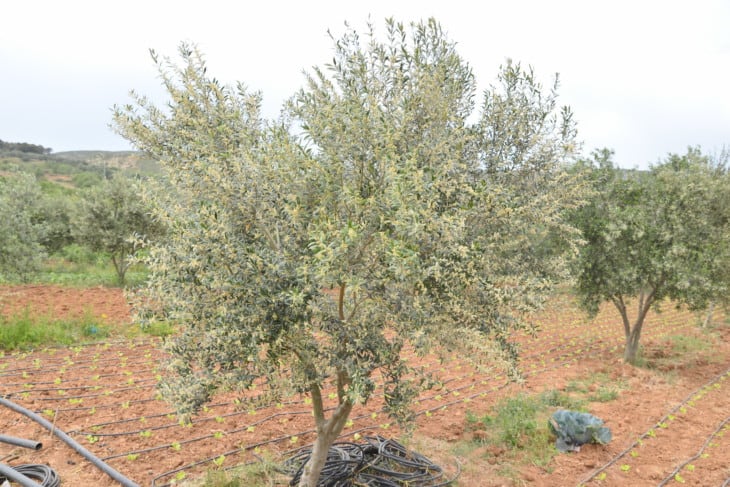
The Chemlali olive tree flowers early, yielding fruit in about 1 to 2 years. However, the fruit is relatively small. Therefore, it’s used primarily for producing oil. Moreover, the oil produced is of high quality, creating a unique flavor that resembles that of apples.
24. Columella
The Columella olive tree is a medium early ripening tree. That said, the fruit can get bruised easily, so it’s best to harvest it early. In addition to that, the oil from the fruits has an aromatic, fruity, and sweet flavor, balanced well with pungent and bitter flavors too.
25. Coratina
The Coratina olive tree is known for producing a high yield of oil, and the quality is great too. The high presence of polyphenols gives the oil stability and a bitter flavor if harvested when the olive is green. Harvesting it when it’s ripe yields oil with a fruity flavor and moderate bitterness.
26. Hojiblanca
The Hojiblanca olive tree is known for producing a low yield of oil. However, the upside is that the quality of the oil is fantastic. The oil’s flavor is fruity with only a bit of bitterness and pungency. Also, the plant has a medium-density canopy, and it’s resistant to cold weather.
27. Itrana
The Itrana olive tree originates from Italy, and it’s a self-sterile plant. It also has an erect shape. In addition to that, it’s known for producing a constant and good-quality yield of fruit. So, the plant is great for table olives because they’re large, and the oil has a fruity flavor.
28. Leccino
The Leccino olive tree is also originally produced in Italy. The plant has a dense canopy that slightly droops. Moreover, the oil yield on this plant tends to vary with yields in the medium-high range for the most part. You should consider growing this tree if you want a quick yield and live in a place with low temperatures.
29. Lucques
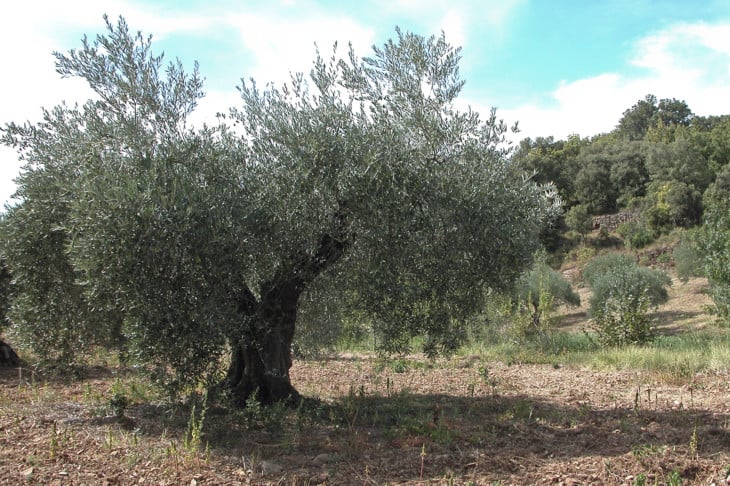
Lucques is a product of France. It has an erect growth habit and a medium vigor variety. Moreover, the flowering is quite early. When the fruit is ripe, it is used to make green olives with great sensory characteristics. The fruit on this tree is not used to make oil often because it’s hard to extract.
28. Pendolino
- Bloom time: Late Spring
- Height: 10 to 20 ft.
- The Pendolino tree is a self-fertile variety. It is best grown in warm climates, and the ripening time is around October to November. You can expect the tree to bear fruit about 2 to 3 years after planting it.
29. Picual
- Height: 25 to 30 ft.
- The Picual olive tree variety has an expansive crown, small branches, and bright green leaves. This plant originates from Spain, and the fruit it bears is considered to be of high quality in the country. The oil yield is also quite high (23%).
30. Taggiasca
- Bloom time: Late Spring
- Height: 15 to 20 feet
Taggiasca is a variety that originates from Liguria, and it produces fruit about 1 or 2 years after planting. The fruit on this plant yields a floral and fruity oil if it is harvested when it’s green. On the other hand, the oil is sweet when the fruit is ripe.
31. Barnea
The Barnea variety is vigorous and has an erect growing habit. The fruiting branches are thin, and the crown is open and loose. Moreover, the leaves have a light green color at the top. It also has a low to good oil yield that can range between 16 and 18%.
32. Biancolilla
The Biancolilla olive tree gets its name from the fact that it has white-colored olives at some point during growth. The olives themselves are medium in size and mature relatively early. They have a wine-red-pink color when they mature. However, the oil yield from the fruit is relatively low (17%).
33. Bosana
The Bosana variety is known for producing a good amount of fruit that’s suitable for producing olive oil. Thus, the yield is medium-high (18%). The fruit, on the other hand, is medium-low in size, ranging between 1.5 and 2.5 grams. Therefore, the fruit is mostly used for producing oil instead of table olives.
34. Bouteillan
The Bouteillan variety is from France originally. It produces high amounts of oil, so it’s mostly used for olive oil production. However, it is also used for producing table olive. The fruit has rounded ends and a rough surface. Also, the olives are burgundy in color when they are mature.
35. Bidni
- Height: 15 to 25 feet
The Bidni olive tree originates from Malta and is also known as Bitni. The plant is known for producing a low yield of oil but some of the finest in terms of quality (with low levels of acidity). Therefore, the tree is used for table olives and oil production.
36. Canino
- Olea europaea canino
- Bloom time: Summer
- Height: 25 to 40 ft.
The fruit on the Canino olive tree variety is green in color at the start and turns black when it matures. The yield of fruit is high, and the oil extracted from it is of superb quality.
37. Carolea
The Carolea olive tree is another product of Italy. It also has great resistance to the cold. The tree is known for producing table olives of black and green dressing. The large size also makes the fruit pulpy. It’s also known for oil extraction, with a high yield of 20 to 25%.
38. Casaliva
The Casaliva olive tree variety produces a constant and high amount of fruit. At harvest, the olives are dark violet, nearing black. They also have symmetrical ovals with a medium size and weight. That said, the oil yield is high, ranging from 22 to 25%, and it is light and fine.
39. Celyon
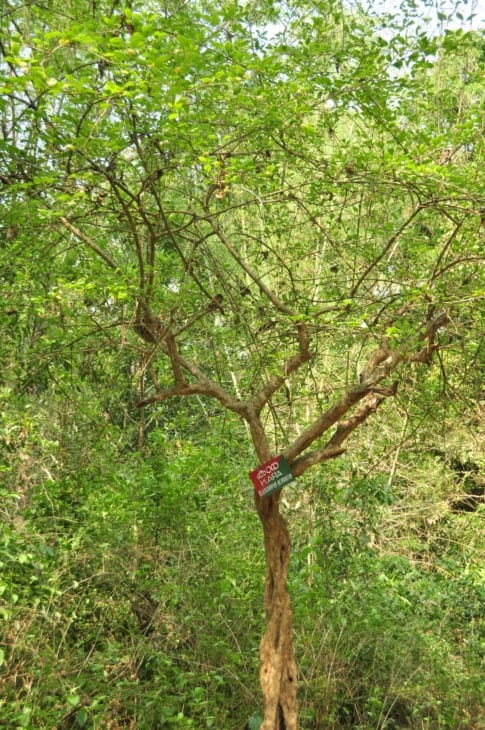
The Ceyon variety is a cultivar, meaning that it is specifically used for pollinating other olive tree varieties. That said, the tree also bears fruit, which is black in color when it is fully ripe. In addition to that, the fruit bears a medium yield of oil (18 to 22%).
40. Cellina di Nardo
The Cellina di Nardo variety originates from Italy and has a high resistance to shedding. The fruit on this tree is too small for table use. However, they can produce a low to medium yield of oil (15 to 18%) if the oil is extracted when the fruit is mature.
41. Cobrançosa
The Cobrançosa olive tree is a variety originating from Portugal. The olive tree also produces a high yield of oil with a constant production. This is because the oil is relatively easy to harvest from the fruit. The fruit is of medium size and has a medium bone to pulp ratio.
42. Conservolea
The Conservolea variety can yield different colored olives, depending on the maturation levels. So, you can collect green olives if you harvest them early. On the other hand, you can get blonde olives if you harvest them mid-early and black olives if you harvest them when they are ripe.
43. Cornicabra
The Cornicabra olive tree is a medium vigor variety with an upright growing habit. The tree is known for a medium to high yield of oil production (19% or more depending on your tree). This is also because the bone to pul ratio of the olives is higher than most other olive varieties.
44. Domat
Domat is an olive tree variety that has a particularly high yield of oil. The percentage can go up to 23%, and this is predominantly because the pulp to bone percentage of the fruit is 89%. So, the olives are fleshy and can produce a consistent amount of oil upon extraction.
45. Dritta
- Height: 20 to 25 ft.
The Dritta olive tree variety has elliptical leaves of medium size, and they have a bright green color. In addition to that, the olives are the color of red wine when they are ripe and ready to harvest. Though the olives are relatively small, they produce a good amount of oil.
46. Empeltre
The Empeltre tree variety has a dense crown and upright shape. The elliptical leaves have a matte dark green color. Also, the tree is great for producing high amounts of oil, ranging between 21 and 23%. Moreover, the black, freckled, and medium-sized (2 to 6 grams) fruit make good table olives.
47. Galega
Galega is a variety known for producing oil that has a soft, sweet flavor with hints of spice and bitterness if the fruit is picked when it’s green. The variety is mostly used for producing olive oil, but it is also used for its table olives in some instances. The oil yield is low, however.
48. Gemlik
Gemlik is an olive tree variety that originates from Turkey. The tree is used for producing table olives and high-quality oil in high quantities. The olives are almost black and have a medium size. The tree is known for producing great quantities of olives in addition to just oil production.
49. Gentile di Chieti (Nostrana)
The Gentile di Chieti (Nostrana) is a variety that originates from Italy. The variety is commonly used for creating high-quality oil with a unique flavor. The oil typically has a medium fruity flavor and a well-balanced level of pungency and bitterness. In addition to that, the level of acidity is quite low.
50. Germaine
The Germaine olive tree variety has good resistance to cold weather and has a good yield of oil. That said, its fruit is also used as table olives. The plant has elliptical leaves that have medium width and are relatively short. On the other hand, the oils are medium weight and symmetrical in shape.
51. Grossane
Grossane is an olive tree that is highly vigorous, and it has an erect growth habit with a canopy of medium density. The leaves have medium width and length. The tree is also resistant to drought and cold. In addition to the tree’s attributes, it produces fruit that tastes sweet.
52. Halkidiki
The Halkidiki olive tree variety originates from Greece. The tree is used to produce two different types of table olives, including green and black ones. The green ones are cured in salted brine. On the other hand, the black ones are harvested at full maturity. Oil is extracted from these olives too.
53. Lechín de Sevilla/Ecijana/Zorzaleña
The Lechín de Sevilla/Ecijana/Zorzaleña olive tree variety originates from spain. The tree is highly vigorous and has large roots and a thick crown. The tree can tolerate bad quality soils, fought, and cold weather. Moreover, the leaves are small, short, and flat. Also, the oil yield is low to medium (up to 18%).
54. Mastoidis
Mastoidis is an olive tree variety that is specifically used as a cultivar. It is mostly used when growing another Greek olive tree variety called the Koroneiki. This olive tree variety is the traditional pollinizer or cultivar in Crete. In addition to that, the Mastoidis olive tree variety also bears fruit.
55. Megaritiki
Megaritiki is an olive tree variety that has medium vigor, and it has a sparse canopy with a drooping growth habit. The leaves on this tree are elliptic-lanceolate of medium width and length. In addition to that, the fruit is used for black and green cured olives and for oil.
56. Memecik
Memecik is an olive tree variety that is particularly common in the Aegean region. What’s great about this tree is that it can produce both black and green table olives. Other than that, the oil yield upon extraction is quite high, ranging from 28 to 30%, depending on the tree.
57. Memeli
The Memeli olive tree variety is specifically known for the olives, used as table olives or consumption. The green olives are used mostly after being preserved in bring. However, there are black olives too. In addition to that, the Memeli olive tree variety is grown in Izmir for the most part.
58. Meslalla
The Meslalla olive tree variety comes originally from Morocco. What’s unique about this tree is the olives that it bears. Thus, the flavors of the olives are considered to be something that olive lovers will specifically love. The flavor is not acidic nor sweet, but it is slightly bitter instead.
59. Morrut
The Morrut olive tree variety has long leaves with medium width. What’s interesting about the Morrut olive tree variety is that the fruit blooms early but harvests after quite some time. So, you’ll have to be patient to enjoy the light and fruity flavors (with bits of bitterness) of the oil.
60. Nabali
- Bloom time: Spring
The Nabali olive tree variety originates from Palestine, but it has been grown in different regions over the years. It has a moderate canopy structure and scattered twigs. Moreover, the fruit is relatively small, with a weight of about 2.5 grams when ripe. The olives turn almost black when mature.
61. Nafplion
The Nafplion variety is not well-known in regions outside of Greece. However, you can purchase them from online or physical Greek stores in your city. The plant is known for its unique-tasting olives—there’s a great balance of sweetness and sourness to it. The fruits are small, bright green, and firm.
62. Nevadillo Blanco
- Bloom time: Late Spring to Early Summer
- Height: 20 to 30 ft.
The Nevadillo Blanco variety can be a great way to improve the appearance of your garden or landscape. The fruit from this tree provides high and consistent quantities of olive oil, making them reliable. The fruit is also ready to harvest early.
63. Olivière
Olivière is a cultivar variety originating from France. It has a drooping growth habit and elliptical leaves. The plant is used specifically for oil production. The fruit doesn’t produce high quantities of oil. However, the tree has a great number of olives when harvesting, so the overall oil yield is high.
64. Patrinia
- Olea europaea var. microphylla
- Height: 10 ft.
Patrinia is a variety of olive trees that is relatively small, which can be great if your garden or landscape does not have much space. This tree is primarily used for producing oil because it produces a high yield of olive oil (25%).
65. Sabine Olive
The Sabine olive variety is not the same as the olive oil that is produced in Italy’s Sabina region. That said, what’s particularly great about this variety is its exceptionally high oil yield. Under ideal circumstances, the oil yield can go up to 30%, which is higher than most other varieties.
66. Salonenque
Salonenque is relatively smaller than other olive tree varieties, and it spreads lows with a globular shape. In addition to that, the fruit flowers early and ripens after a significant period. The fruit has a symmetrical shape, and the pulp to bone ratio is quite high, allowing for good oil yields.
67. Sevillenca
The Sevillenca variety ripens early and produces quality with a complex aroma, such as that of strawberry, banana, fennel, and anise. On the other hand, the flavor is sweet with a bit of an almond taste to it. Moreover, the black olives from this tree are used for table consumption.
68. Sikitita
Sikitita is a low vigor olive tree variety. The flowering time is about average. That said, the tree is known for good oil production. Thus, the oil yield is high, and it’s easy to extract the olive oil from the fruit. However, olive oil has poor stability and is prone to some diseases.
69. Souri
Souri is an olive tree cultivar, and it is also used to grow other olive tree varieties. This variety originates from the town of Sur in Lebanon. Moreover, Souri is known for providing a high yield of olive oil. Also, the flavor of the oil extracted from the fruit is greatly aromatic.
70. Thassos
Thassos is an olive tree variety that is produced on the Island called Thassos, situated in Northern Greece. The fruit on these trees is known as the Throumba olive. They are black in color and relatively small with thin skin. When used as table olives, they have a mellow flavor.
71. Throumbolia
- Height: 15 to 30 ft.
Throumbolia, also known as Chondrolia, is yet another olive tree variety that originates from Greece. It’s not a popular variety, but it is used in the production of table olives and olive oil. It has an exceptionally high oil yield, reaching up to 28% in some cases.
71. Tsounati
Tsounati is a very similar olive tree variety to the Mastoidis variety. Therefore, it is also a product of Greek and is used as a cultivar. In addition to that, the Tsounati olive tree variety also bears fruit, which is predominantly used as table olives. This variety is particularly rare.
72. Verdial
The Verdial olive tree variety has an erect growth habit and medium-high vigor. Moreover, the leaves are long and have an elliptical shape with medium width. This variety is used mostly for producing table olives. The olives are large, green in color, and have a slightly asymmetrical and ovoidal shape.

